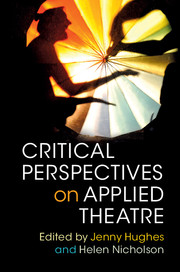Book contents
- Frontmatter
- Contents
- List of figures
- List of contributors
- 1 Applied theatre: ecology of practices
- PART I HISTORIES AND CULTURAL MEMORIES
- PART II PLACE, COMMUNITY AND ENVIRONMENT
- PART III POETICS AND PARTICIPATION
- 10 Applied theatre and participation in the ‘new’ South Africa: a possible politics
- 11 Staging Labour Rights
- 12 The micro-political and the socio-structural in applied theatre with homeless youth
- 13 A good day out: applied theatre, relationality and participation
- Notes
- Index
- References
13 - A good day out: applied theatre, relationality and participation
from PART III - POETICS AND PARTICIPATION
Published online by Cambridge University Press: 05 April 2016
- Frontmatter
- Contents
- List of figures
- List of contributors
- 1 Applied theatre: ecology of practices
- PART I HISTORIES AND CULTURAL MEMORIES
- PART II PLACE, COMMUNITY AND ENVIRONMENT
- PART III POETICS AND PARTICIPATION
- 10 Applied theatre and participation in the ‘new’ South Africa: a possible politics
- 11 Staging Labour Rights
- 12 The micro-political and the socio-structural in applied theatre with homeless youth
- 13 A good day out: applied theatre, relationality and participation
- Notes
- Index
- References
Summary
In 1979, the socialist theatre director John McGrath delivered a series of lectures at the University of Cambridge in which he outlined his manifesto for a working-class theatre that would engage audiences in debating political issues. His vision of a popular theatre was inspired by the Marxist traditions of Brecht and Piscator, and his lecture described how his 7:84 Theatre Companies in England and Scotland performed in working men's clubs, village halls and pubs, places of entertainment that existed away from the polite constraints of bourgeois theatre. This form of theatre encouraged audience participation, and his book, A Good Night Out (1981), documents the dramaturgical methods he used to capture the imaginations of working-class communities using comedy, popular song and local stories that audiences recognised.
Thirty-six years later, the idea that audiences might participate in constructing their own dramatic narratives has spread to what John McGrath might have described as ‘bourgeois theatre’. Contemporary theatre-makers are creating theatrical experiences that put their audiences at the heart of the process, making theatre in non-theatrical spaces that depends on the active engagement of audience members as co-producers of the dramatic event. Artistically successful companies such as Punchdrunk in the United Kingdom and Ontroerend Goed in Belgium use some of the aesthetic and dramaturgical strategies associated with applied theatre, apparently promising audiences agency and the power to make decisions that alter the action, or to negotiate their own way through a labyrinthine set of narrative possibilities. Often taking place in found spaces such as disused shopping malls, factories and warehouses, these theatrical experiences are designed to engage audiences in new forms of participation and spectatorship. This way of working has been commercially successful, perhaps particularly attracting the young, metropolitan arty crowd drawn to an immersive theatrical experience as a part of a good night out. Outside the theatre, participation has become integral to the cultural economy and to the service industries, where everything from shopping to museum visits is sold as an ‘experience’. On the one hand, affective atmospheres are carefully constructed in the heritage industry as a way of encouraging visitors to imagine living in former times. On the other, consumers are seduced into brand-loyalty through shopping experiences that are conceived as good days out and marketed as part of the kind of consumer society Mauyra Wickstrom (2006) described as performative.
- Type
- Chapter
- Information
- Critical Perspectives on Applied Theatre , pp. 248 - 268Publisher: Cambridge University PressPrint publication year: 2016
References
- 12
- Cited by



